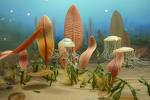 |
 |
 |
 |
 |
Produced
by the Population Genetics and Evolution class, Furman University |
||||
 |
 |
 |
 |
 |
Produced
by the Population Genetics and Evolution class, Furman University |
||||
 |
The
Ediacaran: Eoporpita |
 |
Eoporpita
is an extinct genus of hydrozoans that lived during the Ediacaran Period,
which lasted from 630 to 540 mya (The Paleobiology Database). The first
fossil impression of Eoporpita was discovered at the Winter
Coast of the White Sea in Russia, although more fossils were later found
in South Australia (UCMP 2010). Uranium-lead zircon dating of the surrounding
volcanic ash at the Russian site indicates that the fossil discovered
there formed about 555 mya (Martin et al. 2002). Eoporpita
is characterized by a central body about 6 cm in diameter with thick
tentacles, and researchers initially classified it as a member of the
order Chondrophora. Chondrophorines are somewhat unusual hydrozoan cnidarians
that actually consist of a colony of individual polyps specialized for
various functions, such as feeding or reproduction. However, systematists
have since replaced Chondrophora with the family Porpitidae, and researchers
now think that Eoporpita was not a chondrophorine but rather
a benthic polyp similar to a sea anemone (UCMP 2010). Page by Bob Mazgaj |
 |
| Eoporpita fossil from the White Sea Region of Russia Photo credit: University of California Museum of Paleontology | |
|
University of California Museum of Paleontology (UCMP). Eoporpita from the White Sea Region of Russia. Accessed 26 Jan. 2010. Martin, MW, DV Grazhdankin, SA Bowring, DAD Evans, and MA Fedonkin. 2002. Age of neoproterozoic bilatarian body and trace fossils, White Sea, Russia: Implications for metazoan evolution. Science 288: 841-845. The Paleobiology Database. Eoporpita basic information. Accessed January 26, 2010. |